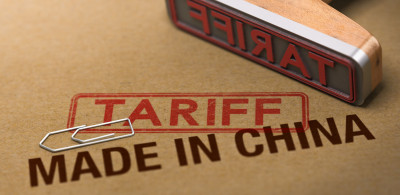Introduction
Pursuant to U.S. Trade Representatives (USTR) Article 301 investigations into China’s unfair trade policies and practices, in July 2018 the U.S. began imposing additional duties (surtaxes) on certain goods manufactured in China imported into the U.S. These Section 301 “surtaxes” are assessed in addition to regular customs duties, merchandise processing fees as well as any anti-dumping or countervailing duties that may apply on Chinese origin goods.Since their initial implementation (List 1), the USTR progressively expanded the number of Chinese-made products (Lists 2, 3 and 4) that became subject to the additional duties under the provisions of Section 301.
- List 1: 25% duties on $34 billion in imports effective as of July 6, 2018
- List 2: 25% duties on $16 billion in imports effective as of August 23, 2018
- List 3: 10% duties on $200 billion in imports effective as of September 24, 2018, increased to 25% effective as of January 1, 2019
- List 4: 10% duties on $300 billion in imports, broken down into two sub-lists:
- List 4A: 10% duties that began on September 1, 2019
- List 4B: 10% duties that began on December 15, 2019
Except for a few products (less than 10 products), which have been granted “exclusions” up to April 2021 most product “exclusions” are set to expire on December 31, 2020. Some “exclusions” have already expired (since September 2020) and have not been extended. As of posting this article, W2C has seen no indication from the current U.S. administration nor from the USTR that gives it reason to believe that these “exclusions” will be extended into 2021, beyond their expiry on December 31. There is also no certainty as to what the new Biden administration will do, once it comes into power in late January.
Therefore, if you are an importer of record in the U.S. who imports Chinese goods and who is currently taking advantage of any product-specific “exclusions” to the Section 301 tariffs, please be advised that unless the USTR takes further action in the coming weeks, the relevant “exclusion” will no longer apply on goods imported on or after January 1, 2021.
This means that Section 301 “surtaxes” will no longer be exempted (on your previously excluded goods) and will result in significant increases in duty owed (10% to 25%) on your customs entries depending on their tariff classification. For those product-specific “exclusions” still in effect until December 31, please note that any shipments of Chinese goods destined for the U.S. must be entered (released) prior to 11:59 pm on December 31, 2020 in order to be eligible for the Section 301 “exclusion.”
SECTION 301, CUSMA AND THE DETERMINATION OF COUNTRY OF ORIGIN
In this volatile and high-tariff environment, many companies have considered new ways to avoid the Section 301 “surtaxes,” including altering their supply chains to effect favorable changes to the “country of origin” of their goods. For instance, certain companies relocated their production/assembly operations outside of China, many to countries such as Canada or Mexico that have a free trade agreement with the U.S., in order to confer a different “country of origin” on their goods, and that, in an attempt to avoid the Section 301 “surtaxes” when those goods (previously of origin China) enter the U.S.Relocating the Chinese production to a USMCA (aka CUSMA) beneficiary country may not necessarily lead to the desired outcome, especially if the production activity done in the USMCA country (CA or MX) is only a simple assembly which does not result in a “substantial transformation.” In other words, it is possible to have an article assembled in CA or MX (from Chinese materials/components) that is eligible to the USMCA free trade preference (on regular duties) but still finds itself subject to the additional Section 301 duties.
For products assembled in CA or MX from inputs of Chinese origin, the Canadian or Mexican producer may need to conduct three separate origin analyses on the finished article before importing that good into the USA.
1) Origin analysis for “Marking” purposes:
- All products imported into the U.S. are required to be marked with their country of origin.
- Products imported into the U.S. from another USMCA country (i.e. CA or MX) must be marked in accordance with the previous NAFTA Marking Rules of Origin.
- Apart from the “NAFTA Preference Override” provision, which was repealed when the new USMCA came into effect, it appears the three countries are only making consequential amendments to their NAFTA and non-NAFTA marking rules.
- Eventually, the NAFTA marking rules will be renamed USMCA (or CUSMA) marking rules, but the previous NAFTA marking rules are not being fully eliminated. It is expected that both sets of marking rules will continue to exist, but all references to the NAFTA in 19 CFR § 102 are expected to be replaced with references to the USMCA (CUSMA).
- The only confirmed reference to the above is found in the USMCA Implementation Instructions (see page 9). The rest is based on informal discussions we have had with customs officials.
- Therefore until further notice, for imports into the U.S. from CA or MX, the country of origin for purposes of marking continue to be determined in accordance with the marking rules set out in 19 CFR § 102, with only Section 102.19 (Preference Override) which no longer applies.
- In order to determine if the product manufactured/assembled in CA or MX is entitled to claim the free trade preference under the USMCA, and thus be certified on a USMCA certification of origin, that product must qualify as an “originating” good in accordance with the rules of origin set out in the USMCA, which are reproduced (for purposes of import into the U.S.) in General Note 11 of the U.S HTS.
- Please note that the marking rules under 19 CFR §102 may render a country of origin which is different from the “originating” country resulting from the USMCA preference analysis.
- For products “assembled” in CA or MX that contain a significant amount of Chinese materials and/or components, the producer may need to conduct a third origin analysis based on the “substantial transformation” test (see 19 CFR § 134).
- This third origin analysis may be required to ascertain if the Chinese materials and/or components have undergone a “substantial transformation” as a result of the assembly process done in CA or MX.
- While you may have a finished article that qualifies as an “originating” good in accordance with the USMCA, and thus entitled to the free trade preference to relieve the regular customs duties and the MPF, the “substantial transformation” may render a country of China, thereby subjecting the product to the additional “surtaxes” under Section 301.
- For more details on “substantial transformation” and Section 301 tariffs on Chinese goods, please refer to W2C’s previous article Be Wary of Surtaxes on Chinese Products.
ENFORCEMENT MEASURES:
- In the course of a customs examination or audit, if the product is found to be marked with the incorrect country of origin, U.S. CBP can assess a marking penalty to the importer equivalent to 10% of the value of the goods, in addition to any duties and taxes normally applicable.
- During an audit, if U.S. CBP finds that the product was not entitled to the USMCA preference, CBP can reassess the importer for the retroactive duties, MPF and interest charges that would become owing.
- During an audit, if U.S. CBP finds that the origin for purposes of Section 301 tariffs was incorrectly declared (i.e. not correctly declared as origin China), CBP would reassess the importer for the Section 301 “surtaxes” (10%-25%) that would become owing, plus interest charges.
- In addition to the foregoing measures, if CBP finds that the importer was grossly negligent or fraudulent in managing its origin declarations, so as to circumvent any additional duties and levies, CBP is within its rights to sanction additional penalties against the importer of record that can reach as high as 100% of the value of the subject goods.
- Training courses and seminars on management of origin preferences
- Determining correct HS Tariff Classifications (needed to ascertain applicable rules origin)
- Carrying out origin analysis and setting up satisfactory audit trail
- Duty recovery and post-entry corrections
- Audit support during CBSA or CBP origin audits
- Requests for Advance Rulings (CBSA) or Binding Rulings (CBP) on origin

